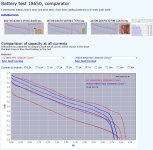Just put together a 12.8V 100Ah LiFePO₄ power supply (1.28kWh) for a, near 80 year, old friend. They saw the movie, (cautionary tail imo), Nomadland and mistook it as an admirable life choice.
Anyhow, they need lighting, plan on using an electric blanket, and require a C-pap machine, so, liable to kill vehicle battery pretty quick. I decide on using Lithium-Iron over Lithium-ion due to the more compatible charging voltage, ≦14.4V is perfect for charging LiFePO₄. Just start vehicle and plug into cigarette lighter socket for up to 30A charge.
Well not quite that simple, you need 30A current regulation and a directional diode to prevent backup discharge, most lighter socket have a 30-40A fuse. Lucked into finding a cheap solar panel charge controller:
10A 20A 30A Dual USB Solar Charge Controller PWM 12V/24V Auto Battery Regulator with a LiFePO₄ mode! Has dual usb, voltage meter and on/off output power.
Of course, running a vehicle for several hours for recharge is not often practical so I modified a Meanwell S-320-12 for 14.2V. Had ordered a generic S-600-12 but was sent a S-600-24 instead, and needed something for 4th of July week long trip.
OK, Meanwell S-320-12 oem adjustable voltage is about 9.7-13.8V, which falls way short of effective LiFePO₄ charging which is variously rated from >14V to ≦14.6V. Now the Meanwell S-320-12 is one of the less common\documented models and I had to find the resister in series with the pot to adjust the voltage up. Turned out to be R48, right next to the pot. Metered at 1200ohm. Limited resister selection so tried 500ohm in parallel and faulted the unit, reset and tried 500+350=850ohm and faulted, 1000ohm, my highest worked but allowed adjustment from 12.7V - fault above 16V. recommend 2000+, maybe 5000ohm resister in parallel or 820ohm? replacement for best function.
25A rated Meanwell will over heat into 30A charge controller so temporarily "regulated" with 6' 16awg connection cord.
Replacement 600w 50A PS ordered and will bypass. solar controller for quick charging with dual 12awg leads. If unit overdraws ...
Will dive into S-600-24V cut voltage down to 14.4 and rely 25A x 135% surge regulation for 33.75A charging.

